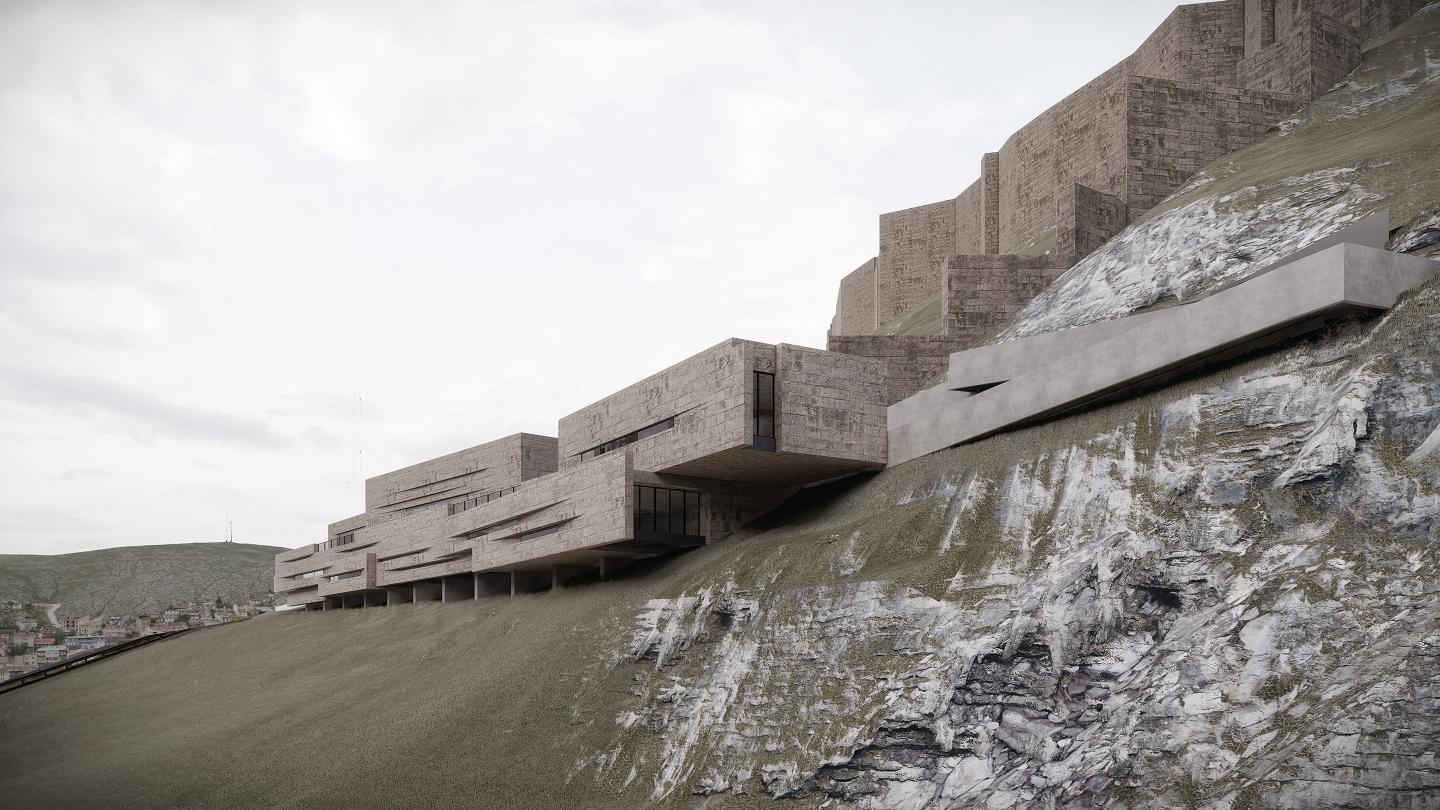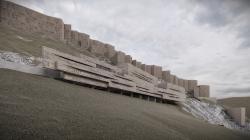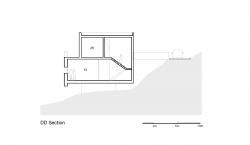With a design philosophy derived from the topography, history and urban texture of the city, Chinimachin Museum forms a new cultural focus and public space for the city of Bayburt and its visitors. The museum aims to establish a dialogue between the urban center and the historic fortress of Bayburt whilst exposing the city’s historic values.
Chinimachin Museum is situated on the foot of the hills forming a boundary between Blacksea and Bayburt. The city, surrounded by the mountains both in south and north, is a large valley and thus has a characteristic topography, which has been a dominant factor during the establishments during the historical ages. The strong dialogue between the existing topography and the Chinimachin fortress has been the focal point for the formation of the cityscape. Chinimachin Fortress, built around 200 A.D, takes its name from the delicate blue, purple and green precious tiles called “Çini”, on it west and south facades.
Chinimachin Museum consists of three main buildings next to each other serving different purposes: entrance, exhibition, and service volumes. With three volumes operating as one, the museum anticipates a close relationship to the informal housing of its surroundings and blends in with the existing rocky texture of the hill with its coherent mass organization. Every volume of the museum is supported by a series of vertical reinforced concrete shear walls.
The museum design aims to unify architectural elements with constructional and functional features, resulting in a family of elements that function as volumes, panoramic windows, seating elements, and exhibition displays. Long, linear openings offer panoramic city views for the visitors, whilst natural lighting for the museum is provided by skylights.
Geographical Restoration
Importantly, the topographic continuity of the landscape is retained by raising the structure from the ground. In addition, the informal constructions currently existing on the site – unregulated buildings hosting cafeterias – will be reconstituted in the functions of the new building, the museum cafeteria and restaurant, which will aim to reemploy the previous local occupants.
Inhabited Wall
The wall is envisaged as an inhabited architectural element, drawing on the castle wall typology, with niches and cavities that can house different functions. The internal spaces are used as seating elements, lighting niches and panoramic windows; meanwhile making the space of the display elements legible on the facade. These openings are horizontal and linear, differentiated from the vertical archetypes of the castle wall, thin and deep observation slits that provide panoramic images to the city, with different heights determined for different types of people (women, men, children).
Sustainability
The facade of the building, consisting of local Bayburt stone, is designed to preserve the ongoing stone workmanship and reduce the carbon footprint to be spent on transportation. The general illumination of the museum is provided by roof lights in the gallery spaces.
2019
0000
The museum design aims to unify architectural elements with constructional and functional features, resulting
in a family of elements that function as volumes, panoramic windows, seating elements, and exhibition
displays. Long, linear openings offer panoramic city views for the visitors, whilst natural lighting for the
museum is provided by skylights.
Architect: Alper Derinboğaz
Architecture Team: Bahadır Kantarcı, Egemen Onur Kaya, Gamze Kaya, Doruk Kayalı, İzel Beşikçi, Pınar
Kömürcü, Emmy Bacharach
Curators: Prof.Dr. Veli Sevin, Arkolog; Prof.Dr. Necla Sevin, Sanat Tarihcisi
Structural Engineering: Bülent Binici Statik Design
Landscape Design: Praxis Landscape
Electrical Engineering: İÖ Engineering and Consulting
Mechanical Engineering: Yıldırım Engineering
Lighting Design: TEPTA
Geotechnical Drilling and Reporting: Aydıner Engineering












